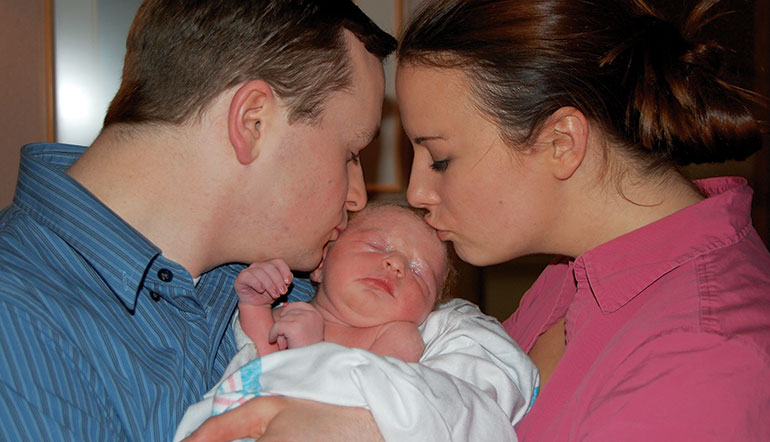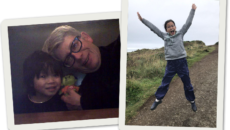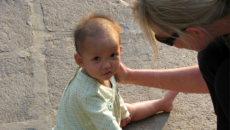Your newly adopted seven-month-old’s records indicate that he’s sleeping through the night–but you’ve found that he wakes up, screaming, every three hours. The 20-month-old you just welcomed home doesn’t seem interested in play–she wants to be held every moment she’s awake. What’s going on?
Children work their way through an incredible number of developmental stages and emotional milestones from birth to age two. Though the timeline varies from baby to baby, virtually all follow the same basic path. And when faced with a major life change, like adoption–and the accompanying loss of all the familiar faces, smells, sights, sounds, and routines–a baby’s response will reflect his developmental stage.
Babies are adaptable, however, and nearly every child adopted in infancy will adjust to and flourish in his new family. But there is a lot parents can do to ease the initial transition following an adoption and establish a strong, lasting bond. We provide an overview of the typical developmental stages from birth to 22 months to help you understand your baby’s behavior after bringing her home, and guidance for how to respond.
[Free Download: Infertility and Adoption Guide]
Birth to Five Months
The first month of a baby’s life is all about meeting her physical needs: to be held, fed, and comforted to sleep. During this time, babies are relatively unaware that they are separate from their surroundings, and are just beginning to associate the care they get with the person who gives it. By month two, however, a baby begins to seek her mother’s presence, by smell and touch, in the same way that she seeks food, a dry diaper, or a nap. Babies also start flashing their first smiles and cooing during this stage.
Adopting a zero- to five-month-old: Your most important task is to enhance bonding by keeping your baby close to you and responding consistently to her needs. Remember that all infants, even newborns, need time to adjust to a new environment and family. They may avoid eye contact, become fussy, refuse to take a bottle, sleep excessively or not at all. This has nothing to do with your parenting skills or whether you gave birth to this child. Only when, in a very rare occurrence, a baby refuses most bottles and has fewer than six wet diapers a day is there cause for concern and medical attention. Try to relax and give your baby time to acclimate.
- Appeal to his senses. Hold off washing the outfit your baby came home in and keep it near him in the crib. Newborns are very sensitive to smell and can be comforted by a familiar aroma.
- Provide primary care. Help your baby learn to identify you and your spouse with comfort by providing all of her care–diaper changes, feeding, soothing to sleep. Tell your friends and relatives that, for at least the first month, you want to be the only ones to dole out hugs and kisses, too.
- Always be there. Your baby needs to know with certainty that you will come when he needs you. A good rule of thumb: No matter what your child’s age at adoption, respond to his cries or calls verbally or physically within 15 seconds.
- Snuggle up. Babies can’t be spoiled by too much holding time. Associate food with comfort by holding, rocking, and singing to your baby while you feed her. Lay your baby on your chest and enjoy some skin-to-skin contact right after a bath. Carry your baby in a front carrier so she can hear your heartbeat.
- Get social. Interact with your baby by smiling and mimicking his coos. Be careful to avoid excessive eye contact, though–he’ll look away, close his eyes, or fuss when he’s had enough. Speak quietly and move with gentle motion. Most infants will startle at sudden movement.
[Getting in Shape for Your New Arrival]
Five to 10 Months
Babies at this age become increasingly aware of themselves as separate from their mothers. A classic sign that this stage, known as “differentiation,” has begun is when a baby begins to prefer facing away from his parent when being held, so that he can see the world around him. But even as a baby stares with fascination at strangers around him, he’ll frequently look back to his mother for reassurance.
A baby’s gains in social and motor skills during this period enhance this initial exploration. Between the ages of five and 10 months, babies start babbling in multiple syllables and typically begin sitting unassisted, start crawling, and maybe even learn to walk.
By six or seven months, however, most babies develop stranger anxiety–fear of unfamiliar people. Soon after, babies usually develop separation anxiety–they may cry and cling when their mother leaves, and be withdrawn until she reappears. At this age, a baby can’t understand that, even though you go away, you’ll be back.
Adopting a five- to 10-month-old: Babies who’ve already developed separation anxiety by the time of their adoption may become intensely sad or fearful. A baby’s innate curiosity about the world may slow down. At the same time, his natural fear of strangers may be exacerbated. “After six months with his birth family, our seven-month-old became deeply depressed when he was placed with us,” says one mother. “He was inconsolable.” Sleep disturbances or night terrors are common for babies moved at this age.
[Free Webinar Replay: Baby Care Basics for Adoptive Parents]
Babies adopted from orphanages or institutions may arrive with “self-soothing” behaviors, like rocking or head-banging. “Seth came to us at five months,” says his mom, Gina Hagler. “He interacted well and smiled readily. But he never cried. When he wanted us, he either banged his head on the floor or screamed at the top of his lungs.” Go back to basics. Even if a baby resists at first, try to hold her in a nursing position, perhaps even loosely swaddled. This may work best while giving a bottle before bedtime or a nap. The goal is to revisit and reinforce the eye contact and relaxation usually achieved during the nurturing of earlier months.
- Allow your baby to grieve. The cry of a grieving baby is painfully different from any other cry. However difficult you find it, stay with her, even if she won’t accept consolation. Try singing, walking, rubbing her back.
- Go with what works. “We knew Lucy had been carried around by her foster mother for several months in the traditional Korean carrier,” says Anna Marie Bonafide. “So we tried to keep her close, taking her in a carrier when we went shopping or even while doing chores around the house.” Stay with her during self-soothing behaviors. “I decided that, if Seth wasn’t going to cuddle with us, I was going to hold him anyway and let him bang his head on me,” says Hagler. By participating with your child, you’ll help him associate you with comfort.
- Maintain your baby’s routines. Now’s not the time to change feeding or nap times. Routines are reassuring.
- Keep it playful. Play peek-a-boo, sing a song, smile. The more your baby associates positive feelings with you, the stronger the developing relationship.
Nine to 18 Months
Walking, and then running, babies of this age discover toys, love to chase and be chased, and explore with fascination. At the same time, they check back visually and physically with their mothers for reassurance. Refueled with a hug or a smile, they are off again to continue their adventures.
Babies at this stage begin to internalize the security they’ve absorbed from their mothers. She may cling to a “transitional object”–a favorite blanket or a stuffed animal that provides symbolic reassurance as she explores the world. Stranger anxiety is still a reality during this phase, usually peaking at about 12 months, then subsiding by the time a child turns two.
Adopting a nine- to 18-month-old: A baby adopted during this stage of life needs to transfer the trust he’s developed with previous caretakers to his new family. Age and mobility are not universal indicators for predicting a baby’s adjustment to a new family. If possible, try to observe the baby with his pre-adoption caregivers. If he moves away to play and explore, then returns for reassurance, he is secure. If he moves away without ever checking back, however, he may have concluded that there’s no one to watch over him.
- Revisit earlier stages of development. If your child missed early nurturing, rock him, hug him, give back rubs. Offer comfort, even if he doesn’t seek it. If your child didn’t develop a strong sense of security and attachment to a primary caregiver during earlier stages, he may want to stay close to you and explore the world visually before going on to explore physically.
- Teach your child to check in with you. To help your child know that you are the source of his safety, instill the checking-in behavior. Require that he check with you before playing with toys or leaving the room to play in another room. Make sure that you are there when the baby checks back in, and express joy in his accomplishments.
Fifteen to 22 Months
For many babies, 15 months marks the entry into toddlerhood. At this stage, babies want to do more than they’re capable of and communicate beyond the limits of their language ability. A child may alternate between courting her parents’ love and attention and trying their patience. For the first time since the child was born, parents have to set limits, reinforce positive behavior, and correct negative behavior. Although toddlers see themselves as separate individuals now, they don’t necessarily perceive other children or adults as human beings with feelings; hitting and kicking when stymied is the norm. Increasing understanding of her own separateness leads a toddler to demand her mother’s attention, often by physically pulling at her to get it. A return of separation anxiety, shyness, or fear of strangers is also common during this stage of development.
Adopting a 15- to 22-month-old: Toddlerhood is a particularly difficult stage for a child to be moved. He’s had time to build attachment to a caregiver, and now his greatest fear–losing that person–has come true. His cognitive and language abilities are not developed enough to understand any explanations of adoption.
Children adopted at this age may cling to the new parent for fear of losing that person also. “Gena wanted to be in physical contact with me all the time,” says her mom, Susan Tombrello. “She would plaster herself to the shower door and whimper for me, or she would try to climb up on me just about anywhere I would sit. Cooking was very difficult when she outgrew her baby sling. I somehow learned to do everything with one hand.”
- Prepare your child. Visit your child in the presence of the caregiver before placement. Together, talk to the child about the move before it occurs. It may help to act out the forthcoming adoption in play. If a pre-adoption visit isn’t possible, send your child an album of family photos or a recording of your voice, so you’ll be familiar by your first meeting.
- Help your child identify feelings. Your child’s verbal abilities aren’t developed enough to express his feelings about the change in his life. Help him label emotions, such as fear, anger, and sadness.
- Record the circumstances. Write down as many details as possible about placement day. Take photos. As your child’s verbal skills develop, she will need to rework her emotions about that day. Details will help her understand what happened, why, and what it means.
- Get good advice. Children adopted as toddlers frequently struggle to balance dependence and autonomy. Professional advice can be helpful.



